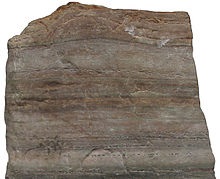 |
| Quartzite, a type of
metamorphic rock. |
Metamorphic
Metamorphic rocks arise from the transformation of
existing rock to new types of rock, in a process called
metamorphism. The original rock (protolith) is subjected
to temperatures greater than 150 to 200 °C (300 to 400
°F) and, often, elevated pressure (100 megapascals
(1,000 bar) or more), causing profound physical or
chemical changes. During this process, the rock remains
mostly in the solid state, but gradually recrystallizes
to a new texture or mineral composition. The protolith
may be a sedimentary, igneous, or existing metamorphic
rock.
Metamorphic rocks make up a large part of the Earth's
crust and form 12% of the Earth's land surface. They are
classified by their protolith, their chemical and
mineral makeup, and their texture. They may be formed
simply by being deeply buried beneath the Earth's
surface, where they are subject to high temperatures and
the great pressure of the rock layers above. They can
also form from tectonic processes such as continental
collisions, which cause horizontal pressure, friction
and distortion. Metamorphic rock can be formed locally
when rock is heated by the intrusion of hot molten rock
called magma from the Earth's interior. The study of
metamorphic rocks (now exposed at the Earth's surface
following erosion and uplift) provides information about
the temperatures and pressures that occur at great
depths within the Earth's crust.
Some examples of metamorphic rocks are gneiss, slate,
marble, schist, and quartzite. Slate and quartzite tiles
are used in building construction. Marble is also prized
for building construction and as a medium for sculpture.
On the other hand, schist bedrock can pose a challenge
for civil engineering because of its pronounced planes
of weakness. |
|
Types of metamorphism
Regional metamorphism
Regional metamorphism, or dynamic metamorphism, occurs
in great masses of rock. Rocks can be metamorphosed just
by being at great depths below the Earth's surface.
There they get high temperatures and the great weight of
the rock layers above.
Much of the lower continental crust is metamorphic,
except for recent igneous intrusions. Horizontal
tectonic movements such as the collision of continents
create orogenic belts. High temperature, pressures and
deformation occurs along these belts. If the
metamorphosed rocks are later uplifted and exposed by
erosion, they are seen as long belts or other large
areas at the surface. |
|